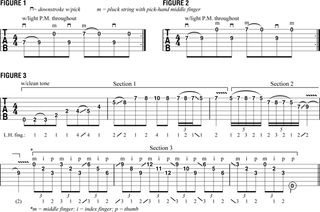
In last month’s column, we looked at a neat pattern and lick in the key of B that incorporated the use of hybrid picking (pick-and-fingers technique). To follow up on and expand upon that topic, I’d like to present two further ideas based on the same pattern, and then show you an elegant run inspired by the great gypsy jazz guitarist Django Reinhardt.
FIGURE 1 is a subtle variation on the underlying pattern from last month’s column. As you can see, it’s nearly identical, the only difference being that for this figure I’ve added an extra open B note at the end of the repeated pattern, which makes for a flowing, unbroken stream of eighth notes. The other idea I wanted to convey is that you can move the pattern across the strings so that the open string is now the high E, meaning you can also use this idea in the key of E, as demonstrated in FIGURE 2.

Now I’m going to take you through a jazzy E minor run that has a Django-esque sound and feel. The lick is played with a clean tone, and as you can see in the accompanying video to this lesson, I’ve selected the middle position on my pickup selector switch so that I’m combining the neck and bridge pickups and effectively getting the best of both worlds—the bright attack of the bridge humbucker along with the rounder, warmer sound of the neck pickup. The run is shown in FIGURE 3. To make it easier to learn, I’ve broken it into three sections.
Section 1 is a fairly straightforward E minor arpeggio that starts with the open low E string, then works its way up and across the neck to the D note on the 10th fret on the high E string via a series of finger slides and position shifts, as indicated below the tab.
Section 2 is very short but a little more tricky due to the speed and timing of the slurred quintuplet figures used. This brings us to the third and final section, which is entirely fingerpicked.
Section 3 calls on you to ditch your pick (as you’ll see in the video, I put mine in my mouth) and use your thumb, index finger and middle fingers to pick the notes. To make life easier, each finger is assigned its own string within a repeating “roll” pattern of eighth-note triplets played across the top three strings, save for the very last note, the open low E string, which I pick with the thumb. Assigning one finger per string in this manner is mechanically efficient and facilitates some serious picking speed once you get the technique and picking pattern down. For this run, the pattern is very simple—it’s just E string, B string, G string, repeat.
What also makes this part of the run fairly easy to play is that the fret-hand fingering shape is repeated up and down the neck. If you’re not used to doing this, don’t worry. Although it might seem a little weird at first, you’ll get used to this style of picking pretty quickly, provided you stick with it.
As always, master each section before moving onto the next. With a little bit of work, you’ll be playing the entire figure at speed in no time.
Get The Pick Newsletter
All the latest guitar news, interviews, lessons, reviews, deals and more, direct to your inbox!

Want to play Master of Puppets the right way? Here's how to get faster at downpicking so you can chug like James Hetfield
![Joe Bonamassa [left] wears a deep blue suit and polka-dotted shirt and plays his green refin Strat; the late Irish blues legend Rory Gallagher [right] screams and inflicts some punishment on his heavily worn number one Stratocaster.](https://cdn.mos.cms.futurecdn.net/cw28h7UBcTVfTLs7p7eiLe-840-80.jpg)
“The intensity of Rory’s guitar playing – the emotion, the sound and his incredible attack – was mindblowing for me”: Joe Bonamassa pays tribute to the late, great Irish blues-rock icon Rory Gallagher









